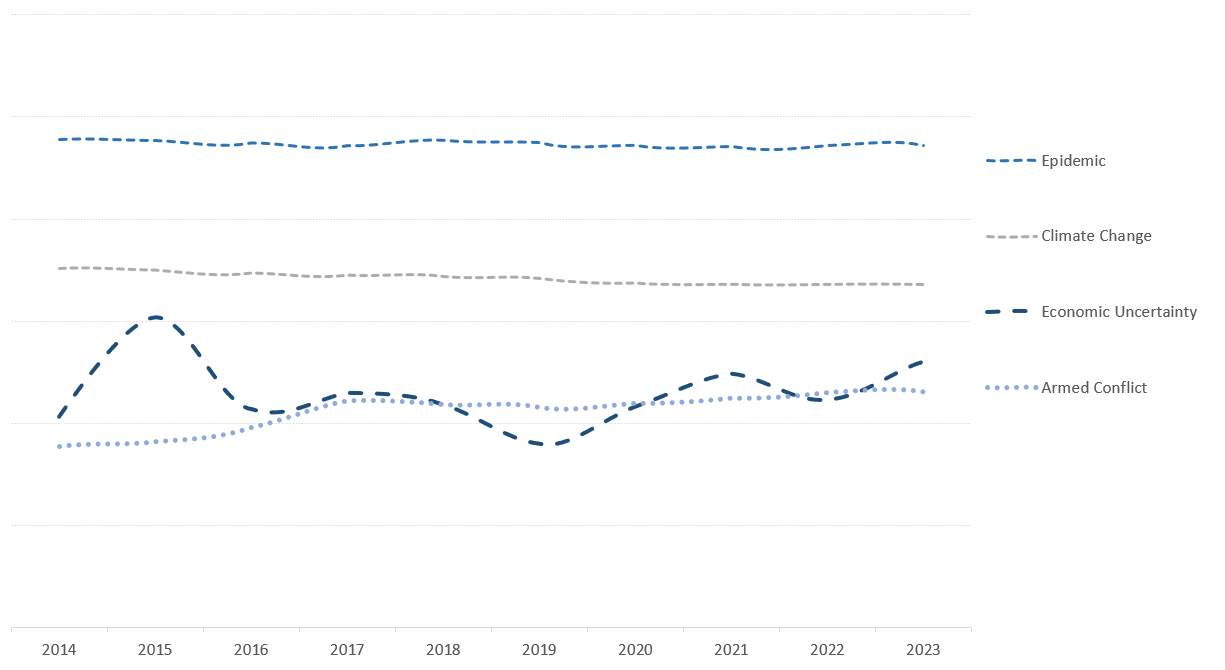
Misperceptions of Risk: How they undermine global risk resilience
The WEF Global Risks Report (GRR) is built on a foundation of nearly two decades of original data on global risk perception. The clue, of course, is in its name, the Global Risks Perception Survey (GRPS) which focuses on the views and perceptions of nearly 1,500 global leaders on the nature of global risks.
John Scott, Head of Sustainability Risk, Debora Iannuzzi Zubler, Head of Transformation and Governance, Commercial Insurance and Igor Rogach, Data and Analytics Manager
Each annual update of the GRPS includes perceptions of the relative importance of global risks over different time horizons and tries to assess their level of interconnectedness. This is supplemented by the insights of over 200 thematic experts from different Forum communities. But how do these perceptions differ from the realities of the data which underpin global risk development?
Take infectious disease risk, ranked 23rd (out of 34 global risks) over a two-year time horizon in the 2024 GRPS and 19th in the ten-year view - down from sixth only two years earlier. How does this match our knowledge of epidemics or pandemics? Are they less or more likely once we’ve just experienced one, or is our perception biased by recency? This is a well understood effect in actuarial analyses of probability. In other words, people rate a risk as more likely if they’ve just experienced the effects of that risk.
It turns out that the data1 on infectious disease risks shows that the risk of an epidemic remains relatively flat over time. Despite the recent COVID-19 pandemic raising awareness about such risks, it did not significantly alter the probability or severity of the risk, but importantly, the perception of the risk significantly reduced even after just one year.
Is this a problem? Shouldn’t we all just heave a sigh of relief, say “thank goodness that’s over” and get on with our lives? After all, there are enough other more pressing issues and global risks to consider and to keep global leaders occupied. Perhaps, but not if we want to truly ensure global risk resilience.
Despite the COVID-19 pandemic raising awareness about such risks, it did not significantly alter the probability or severity of the risk of infectious disease outbreaks2. Importantly the lessons of the pandemic, so ably highlighted in the 2022 GRR in the section “Refreshing resilience” are at risk of being forgotten.
The trend of longevity and ageing populations in all regions other than Africa, is leading to an even greater requirement for healthcare systems that manage the chronic diseases of old age. Cancers, heart diseases and degenerative brain diseases put such a burden on even developed nations’ healthcare systems. These systems can’t manage such burdens if another, even more impactful infectious disease outbreak, takes hold and assumes pandemic proportions.
Misperception or volatile perception of global risks
It turns out that other global risks and, in some cases the structural forces that drive them, are either overrated, or like the infectious disease risks are underrated. In other terms, sometimes the speed at which perception changes is higher and sometimes it is slower than the underlying risk data. Climate Change (as a structural force) and the associated extreme weather events risk is potentially an example of the former.
The excellent work of the IPCC climate scientists on future climate simulations over the next decades as greenhouse gas emissions and temperatures rise, has increased awareness of the long-term effects of climate change. While the climate scientists have high confidence in the increased prevalence of prolonged periods of heat and cold in response to climate change, the more chaotic, severe weather natural catastrophes, are more complex and difficult to understand. Historic data on tropical cyclone frequency has remained relatively stable over time, although their impact has increased. In addition, the growth of the exposure (the value of assets lost in severe weather-related natural catastrophes) has led to an increase in financial losses.
We should be focusing even more acutely on understanding the complex link between climate change and the chaotic severe weather systems, like tropical cyclones, convective hailstorms, and the influence of multi-decadal systems like the El Niño Southern Oscillation. In addition, we should be focusing on creating resilience and preparedness through adaptation, and even more on mitigation of greenhouse gas emissions reductions.
Another important example of a global risk that has almost fallen off the radar is “weapons of mass destruction”. Data on militarization, together with the recent increase in global tensions, does not indicate that either capabilities or motives for weapons of mass destruction have decreased. Nuclear weapons in particular have been subject to proliferation, with more nuclear-armed states, and amongst the more powerful states with the largest nuclear weapon arsenals, there has been a failure to renew strategic arms limitation treaties3.
Preparing national resilience ecosystems for future crises
Sometimes perception increases to catch up with the underlying data, as is the case for climate change, and sometimes it is misaligned with the data, as is the case for epidemic risks and weapons of mass destruction.
So, it is important that we dig down deeper and understand the data behind global risks, in particular their likelihood of occurring and their interconnectedness. Fortunately, there are tools available4 that collate these data and enable them to be visualized at a country level.

Low volatility of health and epidemic, armed conflict, and climate change risk indicators, compared to an example of higher volatility data related to economic risks.
Source: Zurich Risk Room.
Building at a government level, national risk assessments, regulating for resilience and data sharing arrangements help build resilience, not only to infectious disease, but other critical risks like natural disasters. At a business level, we must ensure that supply chain business interruption risks are well understood and mitigated, and nationally important companies have the ability to work together for the common good in an emergency. Then at a community level, resilience is built by central governments and local bodies working together more effectively.
In conclusion, it is essential to continually reassess and recalibrate our perception of risks, ensuring it's in tune with the actual data, thereby facilitating more robust and effective risk management strategies and a world that is more prepared and resilient to global risks.
1 Data from the European Commission Disaster Risk Management Knowledge Centre Epidemic risk measures the likelihood of a country being exposed to and affected by infectious disease outbreaks, based on its level of vulnerability and lack of coping capacity. The exposure is measured by considering the frequency and severity of infectious disease outbreaks, as well as the population affected by them.2 See Hindsight: Reflections on Responses to COVID-19 in the Global Risks Report 2021, 16th Edition, published by the World Economic Forum
3 Under-the-radar risks: understanding and mitigating hidden threats in the global risk landscape. Global Risks Article, by John Scott, Feb 23, 2024, https://www.zurich.com/en/knowledge/topics/global-risks/under-the-radar-risks
4 The Zurich Risk Room (ZRR) is one such tool. A risk assessment tool that harnesses a large amount of data to present quantitative and qualitative analyses of global risks across continents, regions, and countries, including global risks covered by the WEF GRR and the GRPS.


